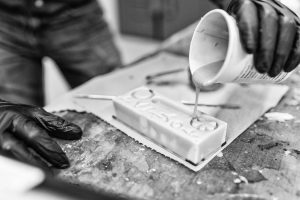Prototyping is an exciting and important part of the medical product innovation process. Prototypes can give you something tangible to touch and feel – a physical representation of your ideas coming to life. Even better, it allows you to better communicate your idea to others (and can help you raise money by having something to show).
Medical product innovators need to be cautious.
Because prototyping is such a fun and exciting part of the development lifecycle, it is very easy to burn time and money unnecessarily. Why? Because it is easy to just keep creating and refining prototypes and falling into a prototyping spiral. Innovators lose sight of what the true purpose of a prototype is. Perhaps they even started without a purpose to begin with.
It is important to know when a prototype is helpful and when it can be harmful to progressing the development process. Below are some of the top items to consider when deciding if a prototype is needed.
Do you know what you are evaluating your prototype against?
- Have you set requirements for your device?
- What are you trying to evaluate? Is it form? Fit? Function?
- Answer: Know what you are trying to evaluate first and always define your inputs before you start. If you have not defined inputs (even if they are loose with a few unknowns), how do you know what to evaluate your design for?
Example: Does my design need to apply a certain amount of force? Does my device need to deliver a certain amount of fluid? Does my device need to function for a certain number of cycles?
Should you combine or separate these evaluations into different prototypes?
- Consider the cost and feasibility of making one prototype that can answer multiple questions versus iterations of prototypes to answer different questions.
Example: Should I pay for the $50k tool for injection molding a silicone part or can I 3D print a mold to sufficiently evaluate my design? Does it need to be the right colors? Do I have 6 weeks to wait for sample units or can I do something quick and dirty?

Photo by Mike Glatzer Photography #mikeglatzerphotos
Does my device need to “work?” What would it take to make your prototype work? What does “work” mean?
- Does it have to perform in a certain way?
- Are you evaluating a particular feature?
- Does it feel the way it needs to? Does it have the right shape? Is it the right color?
Example: Does the device need to turn on? Does the device need to transfer a certain amount of fluid? Does the device fit in someone’s hand? Is my device intuitive for a user? Does my device need to be purple?
Understand what your prototype must do to “work.”
“Types” of prototypes
It is important to know the types of prototypes recommended at different stages of development (proof of concept, appearance model, feasibility unit, pilot unit, etc.) and what your goals are with each prototype. Each evolution should meet specific needs and answer specific questions allowing you to evaluate performance of the design.
Keep in mind, a prototype is a means to an end: a tool to help you answer questions or demonstrate features of your product. Don’t start prototyping without a purpose.
GCMI’s Approach
Throughout each stage of development, GCMI looks at the goals and potentials of each prototype even before prototyping. We have designed our phase-gated development process to follow the design, build, and test strategy that allows us to ensure we create prototypes with a purpose in mind and that prototypes can be used to evaluate design decisions.
Learn more about our disciplined, phase-gated approach to medical product development here.
Read more about how GCMI helped NFANT Labs sprint from ideation to FDA 510k submission in 10 months.
Contact GCMI in the form below.
